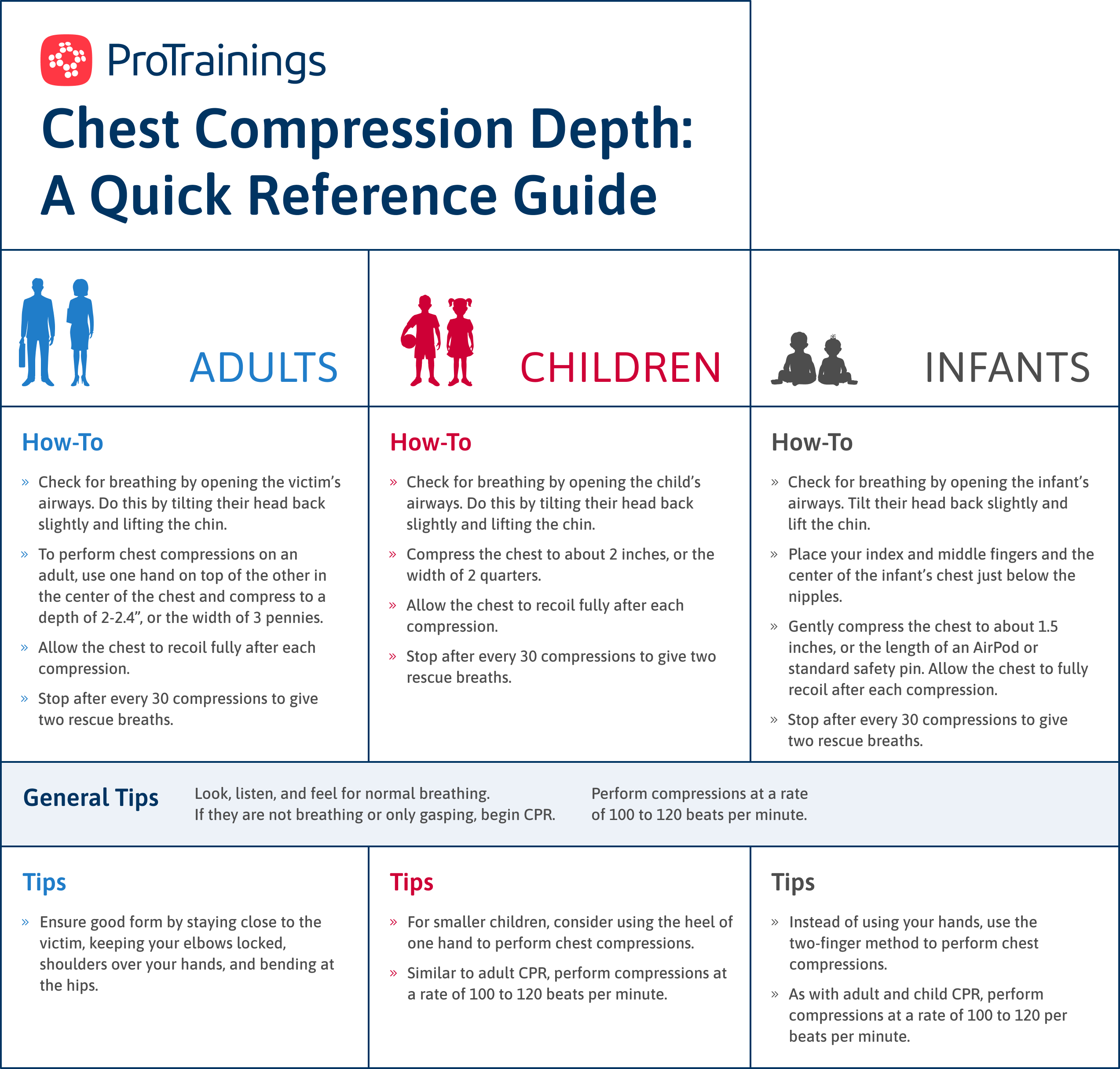Table of Contents
- The Role of Compression Depth in CPR
- What’s the Right CPR Compression Depth?
- Chest Compression Depth for Adults
- Chest Compression Depth for Children
- Chest Compression Depth for Infants
- Chest Compression Depth for Neonatal Infants
- What is the Recommended Compression Rate for High-Quality CPR?
- Does Your Team Know How to Perform Chest Compressions?
Chest compressions are the most crucial part of CPR. They maintain blood flow until the heart restarts, which can slow or prevent the brain damage often caused by cardiac arrest.
Typically, CPR is performed with chest compressions and rescue breaths. However, it can be performed on adults without using rescue breaths at all. This is called hands-only CPR. While hands-only CPR may not be effective for extended periods, it can give the patients a few extra precious minutes of oxygen to the brain before help arrives.
It’s important to remember that hands-only CPR is not as effective for children and babies. Adult lungs are large enough to hold enough air to keep them healthy for the first few minutes of cardiac arrest, so you just need compressions to help that air reach their brain and other organs.
Children have smaller lungs that do not store much air, so they need rescue breaths in order to replenish their oxygen supply. This is why it is so important that parents and healthcare professionals learn how to perform traditional CPR on children and infants.
Learn more about hands-only CPR and start practicing your life-saving skills with this video:
Given how essential chest compressions are, rescuers need to know the proper execution.
The Role of Compression Depth in CPR
Compression depth refers to how much the chest should be compressed during each compression cycle. The depth of chest compressions is significant because it determines how much blood is moved with each compression.
CPR compression depth, rate, and technique must be performed correctly to maximize the chances of survival.
Compression depth may be the most challenging part to master for beginners because they are afraid of hurting the victim. Alternatively, you may not apply enough force to assist circulation if your compressions aren’t deep enough.
CPR compression depth depends on the size and age of the person, so to help you get an idea of how to perform chest compressions, let’s go over the proper compression technique for each age group.
Chest Compression Depth for Adults
Adults require very forceful compressions to keep their blood circulating. Remember that if you’re performing the compressions correctly, you may break the victim’s ribs. That’s a risk you’re going to have to take.
For a quick reference guide on chest compression depths, consult our infographic.

Performing Chest Compressions on Adults
Here are the step-by-step instructions for the technique of CPR chest compressions. These instructions are not a substitute for CPR certification; they can empower you to feel comfortable with the fundamental steps of adult chest compressions.
- Place the heel of one hand on top of the sternum just below the nipples. Place your other hand on top of the hand on the chest.
- Make sure your shoulders are directly above your hands, and your elbows are locked.
- Compress the chest to about 2.4 inches. Allow the chest to decompress fully after each compression.
- Perform compressions at a 100 to 120 per minute rate. Many people use a song to help keep them in rhythm.
- When performing conventional CPR, stop after every 30 compressions to give two rescue breaths. If you are doing hands-only CPR, don’t stop compressing since you need to keep circulation going.
Want to know what sounds to listen for when performing CPR chest compressions? Check out this video:
Chest Compression Depth for Children
For small children, the compression technique is slightly different. Children have smaller chests, so it takes less force to keep blood pumping to their brain and organs.
Children are more susceptible to injury and need less force than adult victims.
Chest compressions should be forceful and deep enough to effectively move blood, but it’s also important to allow for chest recoil between compressions.
Performing Chest Compressions on Children
ProTrainings recommends following these steps to perform child chest compressions. While these steps don’t serve as a replacement for proper CPR certification, they will provide a foundation for crucial emergency support tailored to children.
- Check for breathing by opening the child’s airways. Tilt their head back slightly and lift the chin. Look, listen, and feel for normal breathing. If they are not breathing or only gasping, begin CPR.
- For children aged 1 to puberty (between 8 and 12 years old), use the heel of one hand to perform chest compressions. For children aged 12 and older, you may use one or two hands to perform chest compressions.
- Place the heel of your hand on the center of the child’s chest, just below the nipples.
- Make sure your shoulders are directly above your hands, and your elbows are locked.
- Compress the chest to about two inches, depending on the child’s size. Allow the chest to decompress fully after each compression.
- Perform compressions at a 100 to 120 per minute rate. Many people use a song to help keep them in rhythm.
- When performing conventional CPR, stop after every 30 compressions to give two rescue breaths. If you are doing hands-only CPR, don’t stop compressing since you need to keep circulation going. As mentioned above, hands-only CPR is recommended for adults only.
No matter what, always call for 911 in case of emergencies.
Chest Compression Depth for Infants
Infants need even less force. Their unique anatomy and physiology require special attention! While CPR chest compressions are extremely helpful, rescuers must provide rescue breaths to assist with resuscitation.
The goal of chest compressions in infants is to maintain blood flow to critical organs like adults; however, the depth should be adjusted to accommodate their more fragile bodies.
Performing Chest Compressions on Infants
Our clear instructions can walk you through infant chest compressions so you’re confident in your ability to respond effectively during emergencies. Please note that these guidelines do not replace formal CPR certification but serve as a valuable introduction to infant care.
- Check for breathing by opening the child’s airways. Tilt their head back slightly and lift the chin. Look, listen, and feel for normal breathing. If they are not breathing or only gasping, begin CPR.
- Use the two-finger method to perform chest compressions. Place your index and middle fingers and the center of the infant’s chest just below the nipples.
- Gently compress the chest to about 1.5 inches. Allow the chest to decompress fully after each compression.
- Perform compressions at a 100 to 120 per minute rate. Many people use a song to help keep them in rhythm.
- When performing conventional CPR, stop after every 30 compressions to give two rescue breaths. If you are doing hands-only CPR, don’t stop compressing since you need to keep circulation going.
Chest Compression Depth for Neonatal Infants
Neonatal refers to newborns within their first 28 days of life. Unlike adult patients, where chest compressions take precedence, neonatal resuscitation requires a 3:1 ratio between CPR chest compressions and rescue breaths.
While most neonatal cases have healthcare professionals close by, it’s important to know how to perform chest compressions on a neonatal infant in special circumstances.
Performing Chest Compressions on Neonatal Infants
When it comes to neonatal infants, you’ll likely have a team of healthcare professionals close by, so rely on them whenever possible. They are the experts. However, if you’re in need, you can follow these instructions to perform neonatal chest compressions.
- Check for breathing by opening the child’s airways. Tilt their head back slightly and lift the chin. Look, listen, and feel for normal breathing. If they are not breathing or only gasping, begin CPR.
- Use the two-finger method to perform chest compressions. Place your index and middle fingers and the center of the infant’s chest just below the nipples.
- Very gently compress the chest to about one-half to one inch. Employing this CPR chest compression depth might seem superficial, yet it is a deliberate approach to balance the need for blood circulation without risking harm to their fragile chests. This method aims to provide a secure and effective approach to neonatal resuscitation, recognizing the unique considerations for these precious lives within their first critical weeks.
- Perform compressions at a 120-per-minute rate. Many people use a song to help keep them in rhythm.
- When performing conventional CPR, stop after every three compressions to give one or two gentle rescue breaths. If you are doing hands-only CPR, don’t stop compressing since you need to keep circulation going. As mentioned above, hands-only CPR is recommended for adults only.
What Is the Recommended Compression Rate for CPR?
The rate at which you do compressions is almost as important as compression depth. Maintaining an appropriate compression rate is crucial during CPR to optimize blood circulation and increase the chances of successful resuscitation.
While compression depth varies by age, always perform compressions at 100 — 120 beats per minute.
Many people find it helpful to have a song to keep them in rhythm while practicing compressions. Any song within that tempo range works great — just remember that you’ll probably speed up while performing CPR in real life, so pick a song that is slightly slower than your target rate. You can find a list of great CPR songs here.
For a comprehensive guide to performing CPR on adults, children, and infants, download our PDF.
Does Your Team Know How to Perform Chest Compressions?
Cardiac arrest can happen anytime and anywhere. It can also happen to any person, regardless of age. That’s why it’s so important that healthcare workers of all kinds know how to perform CPR chest compression and other life-saving techniques properly.
That’s where ProTrainings comes in! We have tons of great online materials that your team can use to sharpen their CPR skills so that when disaster strikes, they know what to do. Check out our group CPR training today to get your team members fully trained and CPR certified.
